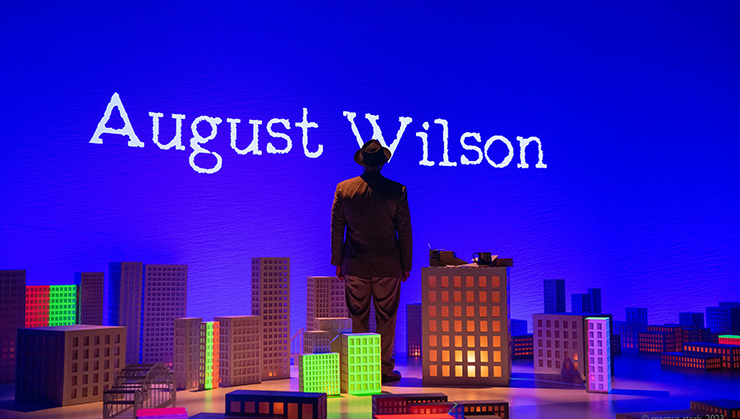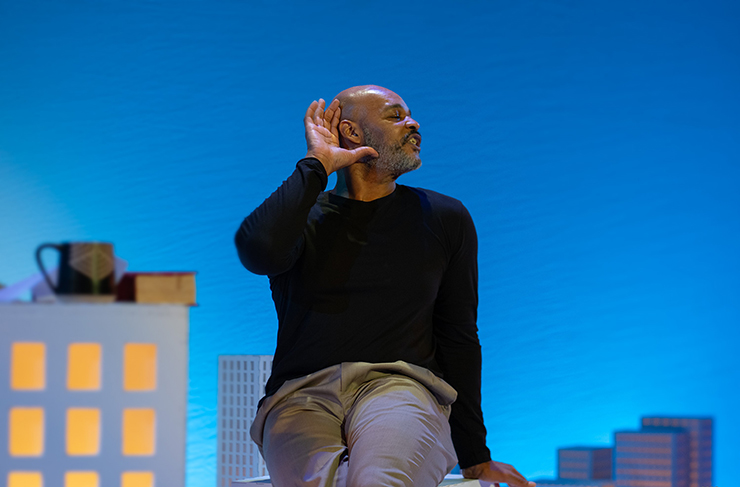
Actor Melvin Huffnagle is August Wilson in the playwright's "How I Learned What I Learned" now at GableStage through Sunday, Oct. 22 at the theater in the Biltmore Hotel, Coral Gables. (Photo by Magnus Stark)
“At the age of 15, I dropped out of school, but I didn’t drop out of life.”
Two-time Pulitzer Prize-winning playwright August Wilson (1945-2005) speaks these words early on in his illuminating and funny autobiographical one-person play, “How I Learned What I Learned.”
Undoubtedly, Wilson embraced life and learning from a young age. Specifically, he read voraciously, wrote poems, worked different jobs, conducted research at the library, and spent time with artists.

The set design by Frank J Oliva of Pittsburgh's Hill District for "How I Learned What I Learned" at GableStage. (Photo by Magnus Stark)
In fact, you can acquire life lessons by experiencing “How I Learned What I Learned.” Fortunately, it is receiving its Miami premiere in a gripping, energetic, and humorous professional production by GableStage through Oct. 22 in the Biltmore Hotel in Coral Gables.
The production stars a vivacious, multifaceted Melvin Huffnagle as Wilson. Meanwhile, veteran South Florida performer and Miami’s own Robert L. Strain will assume the role during select performances.
Both actors received direction from native Miamian Carey Brianna Hart. Meanwhile, GableStage resident dramaturg Karina Batchelor also worked on the production.

Actor Melvin Huffnagle in the closing scene of "How I Learned What I Learned" at GableStage. (Photo by Magnus Stark)
Hart has helmed the production with sensitivity and attention to detail. For instance, she ensures that the actor never becomes a “talking head.” Instead, the performer alternately stands, sits, and walks around the stage. This helps ensure variety and lends the talk-heavy production energy. Also, Hart deftly paces this roughly one hour-and-45-minute, intermission-less production. It is never hard to follow and does not drag.
Judging from opening night, during which Huffnagle portrayed Wilson, Hart has given the actors freedom to express themselves with their whole body. For instance, Huffnagle frequently pairs dialogue with telling gestures and facial expressions. In addition, he uses his expressive, clear, and versatile voice to sound like a variety of real-life people from Wilson’s life.
Wilson, who wrote the play with dramaturg and collaborator Todd Kreidler, gave the piece a subtitle: “And How What I Learned Has Led Me to Places I’ve Wanted to Go. That I Have Sometimes Gone Unwillingly is the Crucible in Which Many a Work of Art Has Been Fired.”

Projection design by Joel Zishuk provides the audience with further, more realistic visual references to the places August Wilson names. (Photo by Magnus Stark)
The play’s listed setting is “The Crucible in Which Many a Work of Art Has Been Fired.” But in GableStage’s production, the literal setting is Wilson’s native Pittsburgh. More specifically, a visually impressive, sturdy-looking, hand-crafted model of structures such as buildings and bridges representing the Steel City grace the stage. Credit, in part, scenic designer Frank J. Oliva and lighting designer Ernesto Pinto.
The actor portraying Wilson stands, sits, and walks within the model throughout the production. Particular locations within the set illuminate as Wilson mentions them. In addition, projection design by Joel Zishuk provides us with further, more realistic visual references to the places Wilson names.
True, Wilson does not teach us how to become an award-winning playwright in “How I Learned What Learned.” Then again, there are some things that you simply cannot teach. Undoubtedly, the gifted Wilson naturally possessed a rare ability to write vividly, poignantly, and poetically about people with whom we can identify. But he also possessed a drive to succeed in life. Indeed, he didn’t let his exit from school as a teenager ruin the rest of his life.

August Wilson's "How I Learned What I Learned" details the playwright's early influences in Pittsburgh's Hill District. (Photo by Magnus Stark)
“How I Learned What I Learned” is essentially one long monologue. Throughout, Wilson introduces us to people who influenced him. Also, Wilson relates anecdotes that helped to shape the person and artist that he became.
You do not have to be familiar with Wilson or his works to find value in “How I Learned What I Learned.” As human beings, we all create things, and this piece celebrates our creative spirit. Of course, if you know Wilson’s work, this piece will enhance your knowledge and appreciation of the legendary playwright.
While we don’t expect him to mold us into award-winning playwrights in less than two hours, it would have been nice for Wilson to impart some insight into his creative process and explain why he loved theater and writing. In fact, Wilson never mentions his plays or the art of live theater in the piece. In fact, the only time we learn about his works is when the pieces’ titles appear on the projector screen at the end. Also, if Wilson revealed why he dropped out of high school, he would become a more sympathetic character. In biographies such as “August Wilson: A Life,” by journalist and theater critic Patti Hartigan, we learn that repeated episodes of racism and taunting by fellow students became too much for him to handle. One day, apparently, he simply had had enough.

Melvin Huffnagle as August Wilson in the playwright's autobiographical "How I Learned What I Learned" at GableStage. (Photo by Magnus Stark)
But Wilson’s daily activities after he dropped out of school obviously prepared him well for his eventual vocation. Indeed, in one of American drama’s highest achievements, Wilson wrote one play for each of the 20th century’s decades, chronicling the African American experience in the U.S. in each piece. Except for one work, “Ma Rainey’s Black Bottom,” all “American Cycle” plays (alternatively called “Pittsburgh Cycle” and “Century Cycle”), take place in Pittsburgh’s African-American Hill District. That is where Wilson grew up. The exception is “Ma Rainey’s Black Bottom,” which takes place in 1920s Chicago.
Wilson won the Pulitzer Prize for two of the cycle plays. Namely, they are “The Piano Lesson,” set in the 1930s, and “Fences,” a 1950s-set piece.
In “How I Learned What I Learned,” Wilson honestly, humorously, and poetically covers topics such as his love life, his experiences working, and the time he landed in jail for three days. Throughout the piece, Wilson paints a vivid portrait of a proud and devoted man with principles who never let anyone push him around. For instance, after Wilson began working in the stockroom of a toy store, his boss told the young man that if he caught him stealing anything, he would shoot him. “I wanted to tell him to ‘kiss my a--,’” Wilson tells us. “But, being my mother’s son, I politely told him, “I quit. Mothered.”
Wilson uses the phrase “being my mother’s son” several times in the play, indicating that he highly regarded his mom, Daisy Wilson. But Wilson, who originally portrayed himself in the piece, also doesn’t shy away from using adult language. That includes using the n-word more than once. And he discusses difficult subjects. They include racism, violence, and drug use.
Wilson divided the play by subheads such as “Wanted: Man to Cut Grass,” and “Something Is Not Always Better Than Nothing.”
The latter is one of the life lessons that the play imparts. For instance, Wilson recounts the time that his mother won a brand new washing machine. She did so by correctly naming the product behind a slogan on a radio program. However, after the powers that be at the radio station learned that Daisy Wilson was Black, “they wanted to give her a certificate to go to the Salvation Army and get a used washing machine. And I can remember her friend, Julie Burley, saying to her, ‘Daisy, what a difference it makes. You got all those kids. Go get, take the washing machine. It’d make your work so much easier.’ And my mother looked at her and she said, ‘Something is not always better than nothing.’”

Melvin Huffnagle's August Wilson uses every inch of the playing area in GableStage's "How I Learned What I Learned." (Photo by Magnus Stark)
Huffnagle, a tall man with dark eyes, bald head, a salt and pepper beard, and a clear, booming voice, commands our attention throughout. He delivers a tour de force performance. To his credit, the actor does not mimic Wilson, but captures his spirit.
The actor is a gripping storyteller who demonstrates deft comic timing. And he speaks with an ease and charisma in front of an audience that suggests years of performing experience. Huffnagle also injects his performance with an impressive spontaneity, sounding as though he is saying Wilson’s words for the first time.
The veteran performer, who is no stranger to Wilson’s work, alters his voice to portray people Wilson encountered during his life. Sometimes he punctuates his words by pumping his fists. This lends an extra dose of conviction to Wilson’s words. Throughout, Huffnagle believably conveys a variety of emotions and alters the tone of his voice for emphasis.
Behind the scenes, Pinto illuminates the performer realistically and uses hues such as red wisely. Appropriately, the designer dimly lights scenes that, for instance, touch on romance and uses more intense lighting for other moments.
“How I Learned What I Learned” shines a light on the life of one of American theater’s most important playwrights. In particular, through Wilson’s deft use of vernacular speech, the playwright’s remarkable yet ordinary characters epitomized African Americans’ trials and triumphs. Hopefully, GableStage’s winning production of “How I Learned What I Learned” will lead to more productions of Wilson’s work at South Florida theater companies.
GableStage’s production of “How I Learned What I Learned” runs through Oct. 22 at the company’s playing space, 1200 Anastasia Ave. in Coral Gables.
Performances take place at 2 and 7 p.m. Wednesday, 8 p.m. Thursday through Saturday, 2 p.m. Sunday (no performance on Oct. 14, but an additional matinee on Oct. 21). Robert L. Strain will play Wilson for 2 p.m. performances on Oct. 4, 11, and 18 and 10:30 a.m. on Oct. 12.
Ticket prices range from $35-$65 plus $10 in fees per ticket.
For more information and the buy tickets, call (305) 445-1119 or go to www.gablestage.org.




